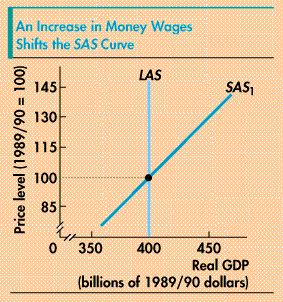Chapter 22
The figure shows the answer to this important question. As the money wage rate rises, the short-run aggregate supply curve shifts leftward. The idea here is straightforward: As the money wage rate rises, firms' costs increase. In response, firms decrease the quantity of output they produce and this action shifts the SAS curve leftward. Eventually, the money wage rate rises by the same percentage as the price level and, at this time, the new long-run equilibrium has been reached. The money wage rate stops increasing and so the SAS curve no longer shifts leftward.
The distinction between short-run aggregate supply and long-run aggregate supply is very important. If you do not have a sound understanding of the difference and the reason behind the difference, you will have difficulty mastering much of the material in many of the subsequent chapters. You want to understand this point! So, in the Economics in Action, Franco also explains the difference between these two essential concepts. In the Study Guide, check out "Learning Challenges" on p. 82. Then work True or False questions 11, 12, 13, 14, and 15; Multiple Choice questions 8, 9, 10, 11, and 12; Short Answer questions 3 and 4. Don't miss any of these questions! Would you like to study another chapter? |
 The basic economic
rationale behind the difference in the SAS and
LAS curves focuses on the response of the
money wage rate. In the short run, an increase in the
price level is not matched by an increase in the
money wage rate. In the long run, the money wage rate
has enough time to increase by the same percentage as
the price level. But, what of the transition between
the short run and long run: What happens to the SAS
curve in the "intermediate run" when the
money wage rate is increasing? In other words, how
does an increase in the money wage rate affect the SAS
curve?
The basic economic
rationale behind the difference in the SAS and
LAS curves focuses on the response of the
money wage rate. In the short run, an increase in the
price level is not matched by an increase in the
money wage rate. In the long run, the money wage rate
has enough time to increase by the same percentage as
the price level. But, what of the transition between
the short run and long run: What happens to the SAS
curve in the "intermediate run" when the
money wage rate is increasing? In other words, how
does an increase in the money wage rate affect the SAS
curve? 